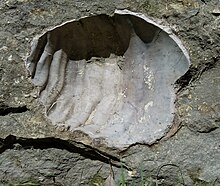This article needs additional citations for verification. (September 2023) |
| Niobrara Formation | |
|---|---|
| Stratigraphic range: | |
 The Smoky Hill Chalk badlands are in the Niobrara Formation, in Kansas. | |
| Type | Formation |
| Sub-units | Smoky Hill Chalk Member Fort Hays Limestone Member |
| Underlies | Pierre Shale |
| Overlies | Carlile Formation Or Benton Shale where the Carlile or Greenhorn Formations are not developed |
| Lithology | |
| Primary | Chalk |
| Other | Shale |
| Location | |
| Coordinates | 42°44′49″N 98°02′24″W / 42.747°N 98.040°W |
| Region | North America |
| Country | |
| Type section | |
| Named for | Niobrara River, Knox Co., Nebraska[1] |
| Named by | Meek, F.B., and Hayden, F.V. |
| Year defined | 1862 |



The Niobrara Formation /ˌnaɪ.əˈbrærə/, also called the Niobrara Chalk, is a geologic formation in North America that was deposited between 87 and 82 million years ago during the Coniacian, Santonian, and Campanian stages of the Late Cretaceous. It is composed of two structural units, the Smoky Hill Chalk Member overlying the Fort Hays Limestone Member. The chalk formed from the accumulation of coccoliths from microorganisms living in what was once the Western Interior Seaway, an inland sea that divided the continent of North America during much of the Cretaceous. It underlies much of the Great Plains of the US and Canada. Evidence of vertebrate life is common throughout the formation and includes specimens of plesiosaurs, mosasaurs, pterosaurs, and several primitive aquatic birds. The type locality for the Niobrara Chalk is the Niobrara River in Knox County in northeastern Nebraska. The formation gives its name to the Niobrara cycle of the Western Interior Seaway.
- ^ "Geologic Unit: Niobrara". National Geologic Database. Geolex — Significant Publications. United States Geological Survey. Retrieved June 5, 2020.
© MMXXIII Rich X Search. We shall prevail. All rights reserved. Rich X Search


